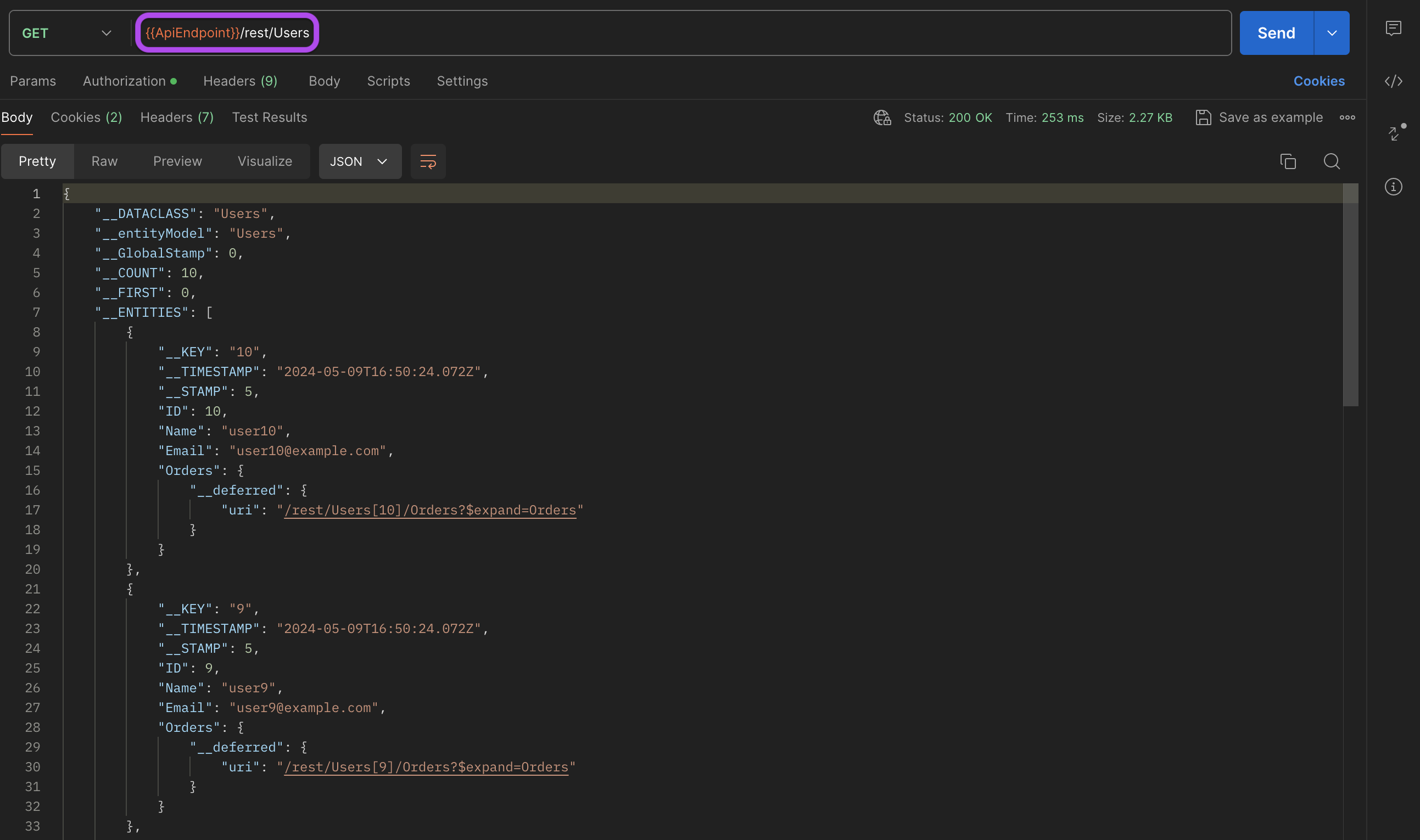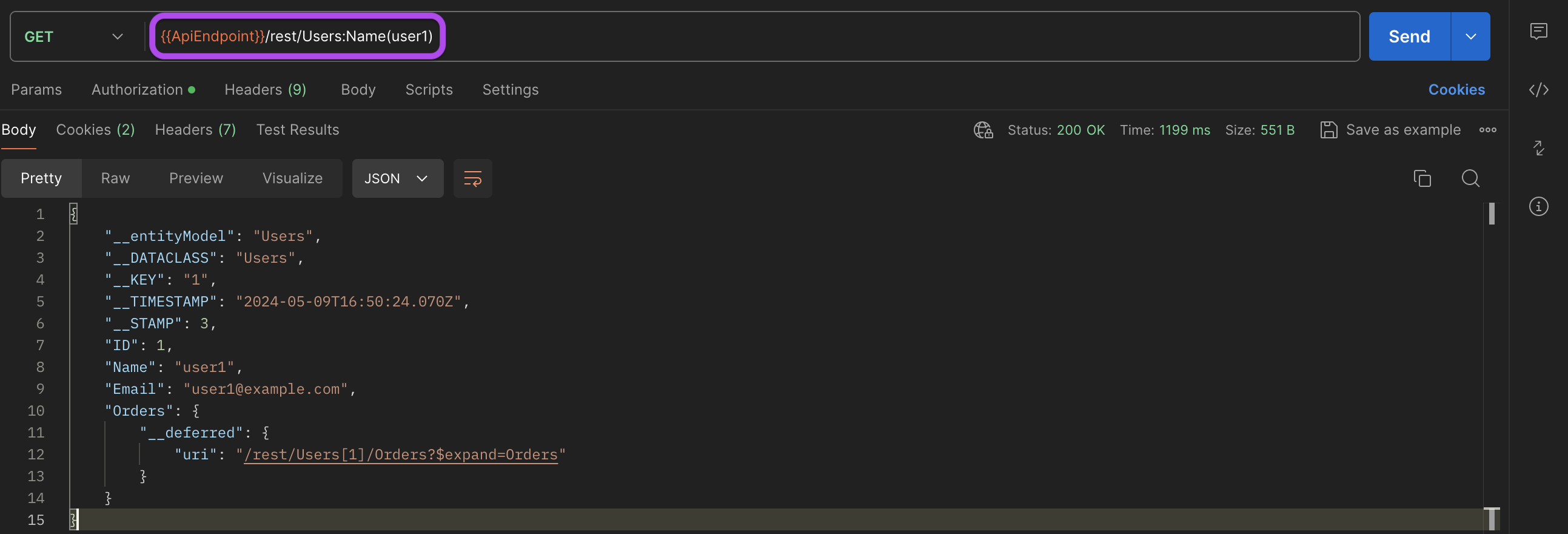Endpoints and Data Access
This section outlines the operations available for interacting with dataClass entities through REST API requests. It includes direct interactions with entities, manipulation through class functions, and detailed querying capabilities.
Available Endpoints
Overview
| Endpoint | Example | Description |
|---|---|---|
/rest/dataClass | /Employee | Retrieves all entities within the dataClass, defaulting to the first 100 entities. |
/rest/dataClass[key] | /Employee[22] | Fetches details for a specific entity identified by the primary key within the dataClass. |
/rest/dataClass:attribute(value) | /Employee:firstName(John) | Retrieves entities where a specific attribute matches the given value. |
/rest/dataClass/dataClassClassFunction | /City/getCity | Executes a class function that affects the entire data class. |
/rest/dataClass/entitySelectionClassFunction | /City/getPopulation/?$filter="ID<3" | Executes a function on a selection of entities, with optional filter parameters. |
/rest/dataClass[key]/entityClassFunction | City[2]/getPopulation | Performs a function on a specific entity identified by the key within the dataClass. |
For detailed descriptions and usage of class functions, refer to the Class Functions documentation.
rest/dataClass
Purpose
The endpoint rest/{{dataClass}} returns all entities within a dataClass, such as Company. By default, the system fetches the first 100 entities unless specified otherwise through query parameters like $top or $limit.
Properties Returned
The rest/{{dataClass}} endpoint returns structured information as outlined in the following table:
| Property | Type | Description |
|---|---|---|
__DATACLASS | String | Specifies the data class targeted by the query. |
__entityModel | String | Specifies the entity model used in the query. |
__GlobalStamp | Integer | Server-wide modification timestamp. |
__COUNT | Integer | Number of entities affected by the query. |
__FIRST | Integer | Index of the first entity in the query results. |
__ENTITIES | Array | Array of objects, each representing an entity within the dataClass with all its attributes and relational links. |
Each entity includes:
| Key | Type | Description |
|---|---|---|
__KEY | String | Unique key for the entity. |
__TIMESTAMP | String | Timestamp of the last update to the entity. |
__STAMP | Integer | Version stamp for the entity. |
ID | Integer | Identifier of the entity. |
Name | Integer | Example attribute, e.g., name of user. |
Orders | Object | Example attribute, e.g., details about the orders, using deferred loading. |
Sample Usage Example in Postman
How to Use:
- Method: GET
- URL:
{{ApiEndpoint}}/rest/Users

The response structure for the /rest/Users endpoint looks something like this in practice:
{
"__DATACLASS": "Users",
"__entityModel": "Users",
"__GlobalStamp": 0,
"__COUNT": 2,
"__FIRST": 0,
"__ENTITIES": [
{
"__KEY": "2",
"__TIMESTAMP": "2024-05-09T16:50:24.070Z",
"__STAMP": 3,
"ID": 2,
"Name": "user2",
"Email": "user2@example.com",
"Orders": {
"__deferred": {
"uri": "/rest/Users[2]/Orders?$expand=Orders"
}
}
},
{
"__KEY": "1",
"__TIMESTAMP": "2024-05-09T16:50:24.070Z",
"__STAMP": 3,
"ID": 1,
"Name": "user1",
"Email": "user1@example.com",
"Orders": {
"__deferred": {
"uri": "/rest/Users[1]/Orders?$expand=Orders"
}
}
}
],
"__SENT": 2
}
rest/dataClass[key]
Purpose
The rest/{{dataClass}}[{{key}}] endpoint fetches detailed information for a single entity within a dataClass using its primary key.
The properties returned mirror those in /rest/{{dataClass}}, focused on a single specified entity.
Sample Usage Example in Postman
How to Use:
- Method: GET
- URL:
{{ApiEndpoint}}/rest/Users[2]

The response structure for the /rest/{{dataClass}}[2] endpoint looks something like this in practice:
{
"__entityModel": "Users",
"__DATACLASS": "Users",
"__KEY": "2",
"__TIMESTAMP": "2024-05-09T16:50:24.070Z",
"__STAMP": 3,
"ID": 2,
"Name": "user2",
"Email": "user2@example.com",
"Orders": {
"__deferred": {
"uri": "/rest/Users[2]/Orders?$expand=Orders"
}
}
}
rest/dataClass:attribute(value)
Purpose
The rest/{{dataClass}}:{{attribute}}({{value}}) endpoint retrieves entities within a dataClass where a specific attribute matches a given value.
The properties returned mirror those in /rest/{{dataClass}}, focused on a single specified entity.
Sample Usage Example in Postman
How to Use:
- Method: GET
- URL:
{{ApiEndpoint}}/rest/Users:Name(user1)

The response structure for the /rest/Users:Name(user1) endpoint looks something like this in practice:
{
"__entityModel": "Users",
"__DATACLASS": "Users",
"__KEY": "1",
"__TIMESTAMP": "2024-05-09T16:50:24.070Z",
"__STAMP": 3,
"ID": 1,
"Name": "user1",
"Email": "user1@example.com",
"Orders": {
"__deferred": {
"uri": "/rest/Users[1]/Orders?$expand=Orders"
}
}
}
Attribute Retrieval
Selecting Specific Attributes
You can specify which attributes to include in the response directly in the API request URL. This capability allows users to retrieve only necessary data, reducing bandwidth and improving response times.
Syntax and Examples
| Use Case | Syntax | Example |
|---|---|---|
| Dataclass | Specify attributes directly after the data class in the URL. | GET {{ApiEndpoint}}/rest/Employee/Name,Department |
| Collection of Entities | Specify attributes for a collection of entities, using filters. | GET {{ApiEndpoint}}/rest/Employee/Name,Department/?$filter="Department='HR'" |
| Specific Entity | Retrieve attributes for a specific entity by ID. | GET {{ApiEndpoint}}/rest/Employee[123]/Name,Department |
| Attribute Matching | Fetch entities where a specific attribute matches a given value. | GET {{ApiEndpoint}}/rest/Employee:Department(HR)/Name,Title |
| Entity Selection | Specify attributes when accessing an entity set. | GET {{ApiEndpoint}}/rest/Employee/Name,Department/$entityset/528BF90F10894915A4290158B4281E61 |
Attributes must be delimited by commas, e.g., /Employee/Name,Department,Salary.
Including Related Entities
Beyond direct attributes, the REST API supports fetching related entity attributes using the $attributes parameter, which can streamline obtaining comprehensive entity details in a single request.
Example
To include the employer's name and address along with employee details:
GET {{ApiEndpoint}}/rest/Employee?$attributes=name,employer.name,employer.address